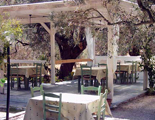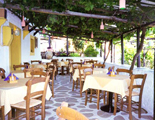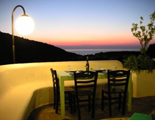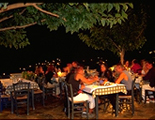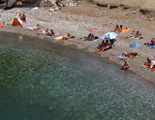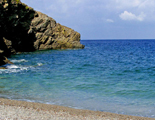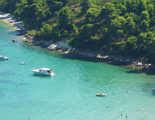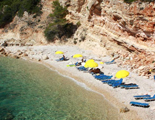
Alonissos Travel Guide
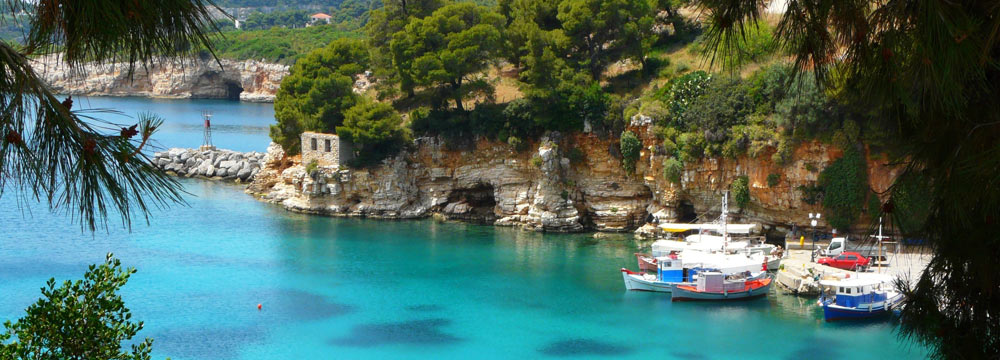
History
Name
The word “Alonissos” is composed of the ancient Greek word “Als”, which means sea and salt in ancient Greek, and the word “nisos”, which means island. So, Alonissos is the island that comes out of the sea. However, the island that we call today “Alonissos” was called Ikos in the Ancient times, whereas Alonissos was the island that today is called “Kyra Panagia”. Alonissos was assigned this name in 1838, when the king of Greece was Othonas. In 1838 all Greek territories that were united with the mainland were reassigned their Greek names after the Ottoman occupation. So, Alonissos was assigned by mistake the name of another island and this name was established ever since. Before the assignment of the Alonissos name, the island was called “Liadromia”.
Prehistoric times
There are signs of inhabitance of Alonissos in the Paleolithic Period at Kokkinokastro, Lefto Gyalos and Glyfa. During that time, Alonissos, the other islands of the Sporades complex and the area of Thessaly in the mainland probably formed a single part of land. Around 1,800 B.C., when prince Stafylos led the Cretans to Sporades, they inhabited also Ikos (i.e. Alonissos). This is when the cultivation of vines and olive trees began, and Ikos became an important producer of wine and olive oil.
Ancient Times
At the beginning of the Ancient times, Ikos was a “dipole” as mentioned by the Ancient geographer Skylax in the 5th century B.C. There were two cities: one at Kokkinokastro, where the ancient wall is still visible, and the other at the position of Old Alonissos, at about 3 km. from Patitiri. In 476 B.C. the island entered the Athenian Alliance, since Athens liberated Ikos from the Dolopians, which were part of the Pelasgians. The Dolopians were dominant at Ikos since the Geometric Period, but eventually they became violent pirates and Ikos suffered during the last years of their dominance. In the classical period, Ikos was very important for the Athenian Alliance due to its geographic position. The Athenians used the island as a starting point for their battles against Philippos. In 190 B.C., the Romans occupied Ikos and there is not much information on the island till the 13th century A.D.
Roman & Byzantine Times
As mentioned above, there is not much information on the island during the Roman period. According to the sophist Filostratos, during the 3rd century D.D., Ikos belonged to Hymnaios, an important wine producer from Peparithos (i.e. Skopelos) and the whole island was involved in the cultivation of vines, production of wine and creation of ceramic pots for its transportation to other places. Later on, Ikos was part of the Thessaly Province, which is the period during which the walls of the castle in Old Alonissos were built.
Venetian Times
In 1204 Alonissos became a territory of the Venetians and, starting in 1207, it belonged to the Ghisi family, a family of aristocrats from Venice. After that, the island was conquered by many different owners and in 1453 it became again a territory of the Venetians in order to prevent the dominance of the Ottomans. Venetians were the island’s owners until 1538 A.D., when the victory of the notorious Algerian pirate Barbarossa led to the beginning of the Ottomans’ occupation (the same thing happened to Skopelos too).
The Ottoman Period
The Ottoman occupation lasted until 1830, when the island was united with the rest of Greece. Right after 1538, many inhabitants left the island and moved to the mainland. Some years later, they returned to Liadromia (this is how Alonissos was called at the time), where the situation during the Ottoman occupation was not that difficult.
Joining Greece
During the Greek Revolution in 1821, many inhabitants from the mainland came to the island and mixed themselves with local inhabitants. The Liadromia inhabitants participated in the Greek Revolution, by helping out whenever it was necessary, but mainly providing ships and sailors. In 1830, Liadromia became part of the First Hellenic Republic under the London Protocol and in 1838 its name was changed from Liadromia to Alonissos.
Recent history
During the 2nd World War, many men from Alonissos lost their lives in battles taking place in the mainland and in the Greek-Albanian borders. However, the most important event in the recent history of the island was the great earthquake in 1965. This earthquake (6.1 of the Richter scale) destroyed the Old Alonissos to a great extend and inhabitants were relocated to Patitiri, which was till then a commercial port. Also, in 1958, the Alonissos vines were attacked by the grapevines pest “phylloxera”, which destroyed the majority of the vines. So, the inhabitants turned to other sources of economic activity, like fishing, animal breeding and agriculture. Another important event in the island’s history took place in 1992, when a part of the sea at the northwestern side of Alonissos was characterized as a Sea Park and, since then, has been protected by international legislation. This has created an increasing interest in the island and its natural environment. Today, the tourism industry is still under development and is gaining an increasing percentage of economic activity, especially from May to September: the wonderful Sea Park of Alonissos, its gorgeous beaches and the unique beauty of pine forests hanging over the sea make the island an attractive travel destination.
Mythology
The name “Achilleiodromia” (Liadromia)
According to the myth, Pileas, the father of Achilles, spent the last years of his life at Alonissos, after being invited by king Molino and his grave was on the island. Since Achilles was more famous than his father, the island was called “Achilleiodromia” that means “the road of Achilles”. Later on, this long and difficult to pronounce name was shortened to Liadromia.
The cave of Cyclops
Cyclops was a dangerous, monocular giant that lived in a cave and was blinded by Ulysses. His cave is considered to be located on the island of Gioura next to Alonissos, which belongs to the municipality of Alonissos. This is the largest cave on the island and it is still unexplored to a large extent.
Hotels
Sightseeing
Churches and Monasteries
Unlike the majority of Greek islands, Alonissos does not have many churches, since they were mostly located in Old Alonissos and were destroyed after the earthquake in 1965. However, there are a few churches worth visiting:
The Church of Christ, in Old Alonissos, which was built in the 12th century A.D. and was among the very few churches that survived the earthquake. It is made of stone but its walls are white painted. This church houses significant Orthodox icons of the 17th century A.D.
The Church of Agios Georgios is another church that survived the earthquake. Built on the highest spot of Old Alonissos it is a picturesque, traditional, stone-built, white chapel. This church offers visitors a magnificent view, while it also houses two unique Orthodox icons of the mid-17th century.
The Church of Agios Athanasios is the third church that survived the earthquake and it was built during the same period as the Church of Christ. It is a quite spacious, stone-built church, which also has a beautiful paved yard and houses a significant Orthodox religious icon of the 18th century and those of the Church of Agios Demetrios, which was ruined by the earthquake.
The Church of Panagia tou Vounou, which means Virgin Mary of the Mountain, due to the fact that this church is built on a mountain slope. The decorative wall paintings inside this church date back to the 17th century A.D.
The Monastery of Agioi Anargyroi at the western part of the island, close to the beach of Megali Ammos. This is a beautiful byzantine church with magnificent views to the western coast of Alonissos.
Museum of Alonissos
This museum is composed by the Historical Museum, the Museum of Folk Art, the Pirate Museum and the Museum of Photographic Cameras. All the above are housed in a four-floor stone building, located at Patitiri. Visitors may admire important historic objects, guns, canons, handcuffs and odd objects used by the pirates, utensils and tools of the everyday life and a rare collection of old photographic cameras, all in the same building.
Patitiri
Although the island’s port, Patitiri, is not exactly what the visitors would expect in terms of architecture, due to the fact that it has been built in a hurry right after the big earthquake in 1965, it is quite picturesque with its beautiful bay and its hills full of pine trees. In Patitiri traditional and modern houses coexist and this village hosts all public services, many shops, taverns, cafeterias and some nightclubs.
Patitiri owes its name to the large number of wine production units, as its name in Greek means the place where the grapes are being pressed in order to extract its juice and has a long history; since the Ancient Times, it was among the most important commercial ports in the Aegean Sea. Wine, oil and several other products where shipped from Patitiri to other ports all around Greece.
Hora or Alonissos or Old Alonissos
This is a magical setting, composed of traditional whitewashed houses with colorful doors and windows, all built on a hill. This used to be the island’s capital, but it was destroyed after the big earthquake in 1965 and many of its inhabitants moved to Patitiri. Old Alonissos has a unique atmosphere with its narrow paved streets, its traditional medieval settlement (that was recently fully restored and is protected by law), the amazing building of the Venetian Headquarters and its castle with the amazing entrance called Palioporta or Kazarma. Starting from Old Alonissos, visitors may arrive by foot to wonderful isolated beaches on the western part of the island, through scenic paths.
Votsi
Votsi is an old fishing village only 1 km. from Patitiri, surrounded by impressive cliffs. Around Votsi there are several imposing rocks forming caves and secluded rocky beaches, accessible only by boat. The village also has some taverns and tends to be united with Patitiri, with houses being built along the road that connects the two villages.
Kalamakia
Kalamakia is a lovely small village in the eastern coast of Alonissos, opposite the island of Peristera. The main occupation of the inhabitants is fishing and this is why there are quite some taverns with excellent seafood and fresh fish. Also, the deck here is ideal for boats and yachts, which usually make a stopover at Kalamakia while sailing in the Aegean Sea.
Steni Vala
This is a coastal village that offers several accommodation choices. It is connected with the island’s capital by bus and increasingly attracts visitors due to the beautiful beaches situated around it and its picturesque ambience. The village also attracts nature lovers and divers, since an organized diving school is located at Steni Vala, while it also has an organized camping and a marina that is ideal for yachters. Last but not least, the Center for the protection of the Mediterranean Seal (MoM) is based at Steni Vala.
Kokkinokastro Archeological Site
The most renowned archaeological site of Alonissos is the area of Kokkinokastro, where there are also signs of inhabitance starting in the Paleolithic period. Visitors may admire the ruins of the ancient city Ikos along with its cemetery.
Agios Demetrios Area
It is also worth mentioning that ruins of a city of the Old Christian Period were found around the beach of Agios Demetrios. This city comprised of houses, baths and a basilica dome.
Various Archeological Sites
What is amazing with Alonissos is that the archaeological sites are even located on the islands around it. For example, on the island of Gioura there is the large cave of Cyclops and on the island Piperi there are findings of prehistoric, classical and byzantine times, including shipwrecks, various findings in caves, old churches and monasteries.
Finally, in the area of Marpounda, there are findings that are possibly ruins of an ancient temple devoted to the Ancient god Asclepius.
Sea Park of Northern Sporades
The Sea Park of Northern Sporades is one of the two Sea Parks in Greece (the other one is on Zakynthos). The park houses 170 species of fish, 70 species of amphipodous and 40 species of sponges. The sea park consists of the area between the southeastern Skopelos and Alonissos, 94% of which is sea. The remaining 6% is composed of little inhabited islands, with great ecological significance and unrivaled beauty.
This is the largest protected sea area in Europe! Visitors can admire the beauty of nature, untouched by the humans, and the largest on the world population of seals of the Monachus-Monachus specie (about 400-500 seals). According to scientists, 2/3 of the total Monachus-Monachus seals, which are considered as the most endangered mammals on earth, live in the Greek seas.
Attractions & Activities not to be missed
Last but not least, visitors should definitely take a boat trip and spend some time on the islands around Alonissos, which host some unique hidden treasures: Kyra Panagia (the Ancient Alonissos) with its beautiful beaches of Agios Petros and Planitis, and the Kyra Panagia monastery; Gioura and Piperi with impressive cave formations and archaeological findings; Psathoura with an ancient city sunk in its port and a large lighthouse; Pappous, close to Kyra Panagia, with a picturesque chapel; and finally Skantzoura with its wonderful bays and the monastery of Evangelistria.
Eat & Drink
TYPE: Restaurant, STYLE: Contemporary Mediterranean Cuisine
Location: Leftos Gialos
TYPE: Taverna, STYLE: Contemporary Mediterranean Cuisine
Location: Old Town
TYPE: Restaurant, STYLE: Italian cuisine
Location: Old Town
TYPE: Taverna, STYLE: Fresh Fish & Seafood
Location: Steni Vala
TYPE: Taverna, STYLE: Traditional Greek Cuisine
Location: Old Town
TYPE: Bar - Restaurant, STYLE: Contemporary Mediterranean Cuisine
Location: Patitiri
Practical info
General Info
CLIMATE
The climate in Alonissos is Mediterranean, which means that the winters are mild and the summers are hot with plenty of sunshine. During the summer, and especially in July and August, the strong northern winds (“meltemia”) make the heat less intense. Alonissos has about 2,000 hours of sunshine per year and the fact that forests cover a large percentage of the island explains its relatively high humidity. However, there is almost no rain during the summer months.
TELEPHONE
The national prefix for Greece is +30 if you are calling from abroad. All numbers in the capital Athens start with the prefix 210 and are followed by 8 digits (e.g. 210-3227400).
The Area Code for Alonissos is: +30 24240. If you wish to call abroad, you have to start by dialing the other country’s national prefix (i.e. 0049 for Germany, 0044 for England etc.) and continue with the area code and the number where you wish to call.
CURRENCY
Euro €
Euro Coins: 1 and 2 euro coins (gold and silver color), 10, 20 and 50 cents (gold color) 1, 2 and 5 cents (copper color)
1 euro = 100 cents / centimes.
Euro Bank Notes: Are available in 5, 10, 20, 50, 100, 200 and 500. It is not always easy to receive change for 200 and 500 Euro Notes.
Getting There
BY AIR
Alonissos does not have an airport. The closest airports are located on the island of Skiathos and at Volos on the mainland, with which Alonissos is connected by boat on a daily basis.
BY BOAT
Alonissos is connected by boat and flying dolphin/catamaran with the ports of Volos and Agios Konstantinos, on the mainland, and with the islands of Skiathos and Skopelos, all on a daily basis during the summer. The trip by boat from Agios Konstantinos lasts about 4.5 hour, from Skiathos 2 hours and from Volos 4 hours.
Moreover, Alonissos is connected with the port of Kymi on the island of Evia and the boat trip from Kymi lasts about 2 hours and 10 minutes.
Alonissos is also connected by flying dolphin and catamaran with the port of Thessaloniki and the trip lasts 4 hours, whereas by the standard boat the trip lasts 6.5 hours.
By flying dolphin, the trip durations are significantly reduced: from Volos the trip lasts 2 hours and 45 minutes, from Agios Konstantinos about 2 (nonstop) to 2.5 hours, from Skiathos 1.5 hours or 20 minutes if it is a nonstop trip, and from the port of Glossa at Skopelos the trip lasts 1 hour.
Note: Flying dolphins and catamarans transfer only passengers (not cars).
Alonissos also has a heliport, which is mainly used for the urgent transportation of sick/injured persons to the hospitals of Athens and Thessaloniki.
For information on ports and schedules, visit the following links:
Hellenic Seaways: www.hellenicseaways.gr
SAOS Ferries: www.saos.gr
G.A. Ferries: www.gaferries.gr
BY CAR/KTEL
Agios Konstantinos is about 165 km. from Athens and it is an almost 2 hours’ drive. Alternatively, Volos is 324 km. from Athens and the trip lasts about 3.5 hours by car and more than 4 hours by KTEL. Kymi is about 175 km. from Athens and it is a 2.5 hours’ drive. Volos is closer to Thessaloniki (210 km.) and the trip lasts 2 hours by car and 2.5 hours by KTEL.
Some shipping companies have their own buses that start from the center of Athens (Kaniggos Square) and carry passengers straight to the port of Agios Konstantinos on the mainland or Kymi in Evia.
Local Trasportation
LOCAL BUSES
During the summer, the local bus (there is only one municipal local bus on the island) connects the island’s capital Patitiri with Old Alonissos and Steni Vala. The bus tickets are quite cheap (1 Euro) and can be bought in shops located in Patitiri. The shops selling bus tickets will have relevant announcements on their shop windows.
TAXI SERVICE
There are only 4 taxis available on the island. The cost of a taxi drive from Patitiri to Steni Vala is 10 Euros.
Alonissos Taxi Services: Tel.: +30 24240 65751, +30 24240 65449, +30 24240 65061, +30 24240 65425.
WATER TAXI
The water taxis at Alonissos are mainly little boats that take tourists to beautiful secluded beaches. The starting point of water taxis is Patitiri and the usual cost is 5 Euros per person.
BOAT
Daily excursions are organized to secluded beaches all around the island. These excursions are organized by request on a daily basis. For more information:
Off-season Tel. number/Fax number: +30 210 6397865
Local Services
BANKS & ATMS
Only the National Bank of Greece has a branch and ATMs in Alonissos:
National Bank of Greece: Patitiri, Alonissos, Tel.: +30 24240 65777
MONEY EXCHANGE Money can be exchanged in the bank branches listed above.
POST OFFICE
The Greek post office is called ELTA and you can find the main post offices of the island in Hora where there is also a branch of the Hellenic Post Bank. Post Boxes in Greece are YELLOW for normal post, usually with 2 slots for INTERNAL POST (meaning inside Greece) and post for ABROAD. RED Post Boxes are rarer and they are used for URGENT mail. You shouldn’t expect to find such boxes in the island. REGISTERED mail is always handled and given a receipt for at the POST OFFICE.
The Post Office on Alonissos is located in Patitiri.
Alonissos Post Office Tel. no: +30 24240 65560
POLICE STATION
Alonissos Police Station Tel.: +30 24240 65205
MUNICIPALITY OF ALONISSOS
Tel.: +30 24240 65555
Useful Numbers
- Radio Taxi: +30 24240 65751, +30 24240 65449, +30 24240 65061, +30 24240 65425.
- Alonissos Flying Dolphins Info: +30 24240 65320
- Alonissos Port Authority: +30 24240 65595
- Hellenic National Meteorological service: +30 2109699101-3
- Elpa (Car breakdown tourist information service): 174
INTERNATIONAL PRESS
NONE
EMERGENCY NUMBERS
- Police: 100
- Fire Department: 199
- Ambulance: 166
HEALTH
Alonissos Health Center: +30 24240 65208
PHARMACY
There are two pharmacies in Alonissos located in Patitiri:
Chlivas Constantinos, Tel: +30 24240 66096
Tsoukana Machi, Tel.: +30 24240 65540
Swim
The archeological treasures around a beautiful beach
Location:Votsi
Tsoukalia is a heavenly beach with sand, pebbles and crystal clear turquoise waters, at the western part of the island. This little bay is surrounded by pine trees and is always tranquil. Right next to the beach, there is also an old windmill, at a very good condition while the entire area around the beach is an area of great archaeological interest (findings date to 400 B.C.), and a large part of it is protected as an official archaeological site. Lucky swimmers will find pieces of pot lodged between the rocks. Tsoukalia is easily accessible by car.
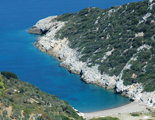
The W-shaped bays
Location:Old Town
Gyalia and Vrysitsa are two almost identical beaches, at the end of beautiful long and narrow bays, forming the letter W with their shape. In the entrance of the Gyalia bay, there is also a picturesque windmill. Travelers may arrive at these beaches either by car (about 20 minutes from Old Alonissos, due to the fact that the road is not covered with asphalt) or by walking down a beautiful path (about 20 minutes from the Old town), and they should make provisions for water, umbrellas and snacks.

The difficult drive's compensation
Location:Steni Vala
Agalou Lakka is a totally isolated beach at the western part of Alonissos. This beach is in the same area with Megali Ammos, an area characterized by wild natural beauty, untouched by the human hand. When visitors arrive at Agalou Lakka, they most probably find it almost isolated and peaceful. Since there is no bar or tavern by the beach, provisions should be made for water and snacks. Although the road that leads to Agalou Lakka is a dirt road, travelers will be compensated by its crystal clear waters and magical tranquility.
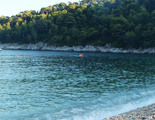
A pleasant trilogy of colours
Location:Isomata
Lefto (or Lepto) Gialos is an organized beach, offering sunbeds and umbrellas, with two taverns and a beach bar, all three also open at night. This marvellous beach is immersed in a trilogy of colours: white for the sand and the pebbles, green for the pines trees around it and turquoise for the transparent sea waters. Due to its unique beauty, this beach is approached by touristic boats coming from Skopelos and Skiathos.
The "long sand" euphemism
Location:Milia
Although Megali Ammos means "long sand" in Greek, this beach is neither large or long nor sandy; it is a pebbled beach of unique wild beauty, untouched by the human hand. The whole area around the beach is secluded and has numerous little beaches worth an exploration (by boat), especially those on the ten deserted islands that suround Megali Ammos. This beach is ideal for nature lovers, and it is wise to approach it by motorcycle or a 4x4 vehicle.
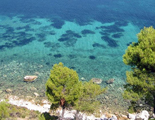
The wild beauty of red rocks
Location:Milia
Kokkinokastro is maybe the most impressive beach on Alonissos, with calm turquoise waters and a unique morphology. The beach lays underneath a steep cliff and is surrounded by large, imposing red rocks. Inside the sea water, at a little distance from the shore, lay the ruins of the sunk neolithic city Eikos, so it is also ideal for snorkeling and underwater explorations. The waters here are deep and cold, and there are sunbeds and umbrellas but no any beach bars. Therefore, visitors should make provisions for water and snacks.
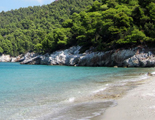
Untouched natural beauty
Location:Milia
Milia is a gorgeous beach with sand and colourful pebbles, while its seabed is marvellous and the waters are crystal clear. This tranquil beach is surounded by pines that create a unique landscape. Swimmers have the opportunity to relish the undeniable, untouched natural beauty of Milia with the rocky cliffs and the green waters, and admire the iridiscent sunset. Sometimes, the smell of the seaweeds reaches the beach which is considered to have therapeutic properties. Access is easy by car and there is also a parking lot next to the beach.
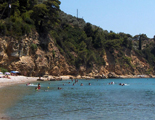
Calm waters and beach amenities
Location:Old Town
Megalos Mourtias is a beach partially sandy and partially pebbled located next to Mikros Mourtias on the southern part of Alonissos which can be reached both by boat or an asphalt road. There are three taverns with delicious food and a deck for yachts. Visitors do not have to carry many things with them, as there are sunbeds and umbrellas and other beach amenities. This beach is quite crowded during the high season, due to the easy access and the fact that it is protected from the northern winds.
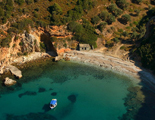
A small, heavenly shelter
Location:Old Town
Mikros Mourtias is a little natural port which was used till the '70s as the port that connected Alonissos with Skopelos. Today it is a peaceful isolated beach with sand and a few pebbles. Due to its position on the southern part of Alonissos and its orientation, Mikros Mourtias is not affected by the Aegean Sea's seasonal winds. Access to this beach is provided via a path from Old Alonissos (in 30 minutes), by car/motorcycle via a dirt road at its last part (10 minutes in total) or by boat. Quite frequently this beach is prefered by nudists.
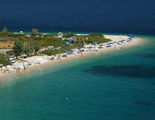
The "white washed" beach
Location:Agios Demetrios
Agios Demetrios is widely considered as the most beautiful beach of Alonissos, due to its variously shaped white pebbles that create a beautiful contrast with its azure waters. This is a very long beach, at one half of which there are sunbeds and umbrellas. The beach also hosts a canteen and a tavern, and has been included in the "10 best beaches of the planet" list. Due to the white colour of the beach and the turquoise waters, swimmers often have the illusion of swimming in a tropical paradise. The last 200 m. of the road that leads to the coast are not covered with asphalt and drivers should pay attention, because it can be quite bumpy.
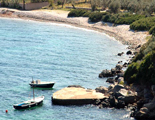
Tranquil bay for explorations' fanatics!
Location:Steni Vala
Glyfa is a spacious pebbled beach at the central-eastern part of the island, next to Steni Vala. This tranquil beach has crystal clear waters and its natural beauty is completed by the green surounding hills and the sea shells scattered among the white pebbles. Visitors have the chance to practice watersports or explore nearby beaches with little boats that depart from Glyfa.
The perfect place for children
Location:Milia
Georgi Gialos is a beautiful beach at the end of a large bay at the eastern part of the island. The waters here are transparent and have lovely shades ranging from dark blue to green and turquoise. Moerover, they are very shallow, which makes Georgi Gialos ideal for children. There is a little tavern by the beach serving food and coffee, and access is quite easy by car.
For watersports' lovers
Location:Marpunda
Marpunda is a spacious sandy beach with impressive rocks on its one side, situated at the southern end of Alonissos. This beach is organized and offers the option for watersports which makes it very popular among young people. The access to Marpunda is easy by car via an asphalt road, but visitors may also get there by boat. A big hotel is located on this beach, for those who would like to spend a second day at Marpounda, while the waters are always calm and crystal clear.
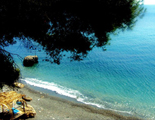
A hidden paradise
Location:Marpunda
Vythisma is an isolated, tranquil bay at southern Alonnisos, close to Marpounda. It has black pebbles and thin sand, as well as natural shade from pine trees that almost touch the sea and "paint" the water with a lovely green colour. Visitors may arrive here by boat or via an almost secret path: on the way to Marpounda there is a sign that indicates the dirt road that leads to Megalos Mourtias. The path which leads to Vythisma starts on this dirt road too. So, visitors need patience and luck, but this marvellous beach will most certainly compensate them.
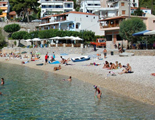
As close to the port as it gets
Location:Patitiri
Rousoum Gialos is a little bay with green waters and white pebbles, at only 800 m. from the port of Patitiri. Although the beach is not organized, there are several taverns around it, serving fresh fish and seafood, and a cafeteria. Its name comes from the Turkish word "Rsum" that means taxes, because this was the port where Alonissos' wine was sold/exported and therefore taxes were paid.

Down a path, straight to paradise!
Location:Agios Petros
Agios Petros is a picturesque isolated bay close to Steni Vala, at the eastern part of Alonissos. Here the pine trees majestically surround the gorgeous coast, which is shaped like a petal, and create a splendid landscape. Visitors should better be trekking lovers, since, in order to arrive to Agios Petros, they will have to walk for about 15 minutes from Steni Vala. However, the peacefulness and beauty of this beach will definetely compensate them. Alternatively, visitors may also reach the beach by boat.
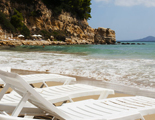
Where scuba divers and families coexist!
Location:Milia
Chrysi Milia is a beautiful, cosmopolitan sandy beach at the eastern part of the island, with shallow clear waters. The transparency of its waters makes it ideal for scuba diving, whereas the sand and shallow waters make it ideal for families with children. There are taverns with excellent food by the beach and umbrellas are available for rent. Chrysi Milia also has a unique view on the little island opposite of the beach.
Map
Local Specialties & Recipes
Alonissos Recipes
Alonissos is a part of the Sporades complex, which are all famous for their wonderful traditional recipes. Specifically in Alonissos, there are some unique recipes made of unique local products, like the Alalunga tuna.
Black linguini with tuna
This dish is not only delicious, but also has a very impressive appearance. The tuna is smashed into little pieces and mixed in a frying pan with sauté onions, tomato, peppers and grated cheese. The linguini is added to the same frying pan one by one after being boiled and this delicious dish must be served while it is still hot.
Frumenty pie (“trahanopita)
This delightful pie is made of traditional, hand-made crust and filled with a special mixture of frumenty, onions, milk, water, myzithra cheese, eggs, salt and pepper. This is actually a quite unusual dish since the pie is filled with a type of pasta.
Pumpkin pie (with spices)
A different version of pumpkin pie which is made of traditional, hand-made crust stuffed with pumpkins, frumenty, sugar, cinnamon, cumin and mint. Then it is baked in the oven and it has a very distinctive sweet and spicy flavor.
Fried cheese pie
A wonderful, simple cheese pie with very few elements: wheat flour, water, salt, goat cheese and extra virgin olive oil. The shape of this pie resembles the shape of a snail shell while the fact that it is fried in olive oil makes it crunchy and delicious!
Bourekia
These are tasteful meat pies, stuffed with boiled goat meat. What is unique about this pie is that the meat is enfolded in six layers of hand-made thin crust.
Hamalia
Hamalia are also known in Alonissos as the “dessert of joy”, because they are traditional candies offered at weddings and engagements. They are made of almonds, nuts, semolina, honey and spices enfolded into triangles of crust and sprinkled with caster sugar.
Fouskakia
Fouskakia are similar to doughnuts; they are made of flour, water and yeast and are fried in olive oil. In Alonissos, just like in Skopelos (another island of the Sporades complex), they are called “fouskakia” because they are shaped in little spheres that look like bubbles (“fouska” in Greek means “bubble”).
Amygdalota (marzipans)
Alonissos’ marzipans are made of trimmed almond kneaded into various shapes using water extracted from lemon flowers for the mixture. Amygdalota (“amygdalo” in Greek means “almond”) traditionally do not have a standard shape but they are sprinkled with caster sugar and have an amazing taste.
Local Products
Tuna
Alonissos is famous for its wonderful tuna fish, which is boiled and pasteurized in glass jars with a traditional procedure. The best tuna specie is “Alalunga” (white, red and yellow).
Noodles and frumenty (“trahanas”)
Alonissos produces wheat and traditional Greek pasta can be found in the shops that sell traditional products. Among them, the most renowned are noodles and frumenty.
Wine
Although the wine production has been dramatically reduced since 1958, the locally produced wine is coveted all around Greece. Visitors should definitely buy a bottle of Alonissos’ “black” (dark red) wine which is pretty difficult to find.
Olives and olive oil
Alonissos has a long tradition in the cultivation of olives and the production of olive oil, just like most parts of Greece. The extra virgin olive oil of Alonissos is also used for the tuna final product (tuna in olive oil).
Pottery
The art of pottery in Alonissos has begun since the Ancient Times. Today, visitors can buy ceramic pots of various sizes, for various uses.
Honey
The fact that Alonissos is to a large extend covered by forests explains why its honey is so delicious. Jars of honey can be found on various shops that sell local products.
Cheeses
The most famous local cheeses are “myzithra” and small round-shaped goat cheeses. These cheeses are also used to make the Alonissos’ cheese pie.
Local herbs
A variety of local spices and herbs are sold in the shops around Alonissos, including its famous oregano and some herbs that are considered to have healing properties. For more information, visitors should ask the shop owners. It is no coincidence that the International Academy of Classical Homeopathy is headquartered in Alonissos.
Events
Carnival Events
Many carnival events are organized in late February or early March on the last Sunday of the Carnival season, including a masquerades’ parade, dancing and partying.
Kalogianneia festival
In early May, the “Kalogianneia festival take place” in honour of the Island’s benefactor Anastasios Kalogiannis. They include sports and cultural events, which are organized in the premises of the High School-Lyceum of Alonissos.
Folk Dance
A folk dance evening is held on May 26 every year, with the participation of the Alonissos folk dancing group.
Marathon
In early June, during the last three years a marathon has been organized attracting athletes from all over the world. Moreover, a special marathon for the disabled is organized annually.
Fisherman’s Evening
A fisherman’s evening is organized on June 16, which includes free wine and food, live music and dancing.
Representation of Wheat Threshing
In July, the Representation of Wheat Threshing is held in Old Alonissos. This is an open air event, during which the traditional way of threshing the wheat is represented with the use of mules. The celebration is completed with live music and dancing.
Traditional Wedding
The Revival of a Traditional Alonissos’ Wedding is held in Old Alonissos on August 14, with traditional costumes called “morka”, live music and dancing.
Religious Feasts
On August 15 the religious feast of Virgin Mary is held, which is celebrated in Old Alonissos with wine, food and dancing. On September 8 the religious celebration of the Birthday of Virgin Mary takes place on the Monastery of Kyra Panagia on the homonymous island, with the participation of monks arriving on this little island by boats straight from Mount Athos. Other religious feasts celebrated with food and live music include the feast of Saint Paraskevi on July 26, the feast of Saint George either on April 23 or right after Easter, and the feast of Saint Konstantinos in a little church in Northern Alonissos.
Other Events
Last but not least, the museums and galleries of Alonissos organize various events, for which visitors may be informed via the Municipality of Alonissos.
Cycladia Tips
Useful tips for a Pleasant Stay
Alonissos is an island that boasts many deserted islands with beautiful beaches all around it. Since it is most likely that guests will visit those isolated beaches by boat, they should make provisions for water, snacks, sunscreen and hats.
In addition, visitors should be aware that the nights at the Aegean Islands are chilly due to the winds and the relatively high humidity. So, a light jacket always comes handy.
Finally, sometimes visitors will need to walk down a path in order to arrive in a heavenly beach. Therefore flat/athletic shoes are needed, which will also be very useful when walking around the narrow paved streets of Old Alonissos Town or when hiking.
Various tips
Prearrange a taxi appointment
Since there are only four taxis available on the island, travelers who wish to use one should definitely contact the taxi services by phone and make an appointment.
Boat tickets should be pre-booked
Since there is a large demand during the summer months, travelers should book in advance their boat tickets. Also, by pre-booking tickets can be bought at a lower price.
Prefer calm beaches when it is windy
The Aegean Sea is often very windy, especially in August due to the seasonal winds (“meltemia”). Therefore, visitors should prefer beaches that offer a natural shelter and have calm waters, like Mikros Mourtias, Megalos Mourtias, and Marpounda at the southern part of the island.
Trekking is a must!
Alonissos’ nature is wonderful and, especially, the northern part of the island is almost untouched by the human hand. Visitors have the opportunity to get in touch with nature and explore the beauties of this magical island by walking around it either on their own or by participating in organized walking/hiking tours of the island.
Take a boat trip and explore the caves
Around Alonissos, on the island itself and on other deserted islands around it, there are gorgeous rocky beaches and many of them offer some interesting caves. It would be a pity for any traveler that has visited Alonissos not to explore this amazing morphologic natural treasure.
Scuba diving
Alonissos is a heaven on earth with its crystal clear waters and scuba diving is allowed and organized in some beaches, like Chrysi Milia, Gyalia and Vrysitsa. Those who have explored the Alonissos’ sea bed will definitely remember it for a lifetime!
Shops & Galleries
Shopping In Alonissos
The majority of shops are located in Patitiri, but shops are also located in Old Alonissos and Steni Vala.
Art objects - Galleries
Gallery 5 (or the Bente Keller Gallery)
This is a wonderful gallery where visitors can find paintings and hand-made candles, but also organizes watercolor painting seminars.
Patitiri, Alonissos
Tel.: +30 24240 65931.
Tsoukalia Ceramic Pots Laboratory
This is a traditional laboratory of ceramic pots located in Patitiri. It is named after the area where in the 4th century B.C. there was an ancient laboratory of ceramic pottery that was used for the transportation of wine all around Ancient Greece.
Patitiri, Alonissos
Tel.: +30 24240 66211.
Traditional products
Women’s Agricultural Association of Alonissos
The shop of the Women’s Agricultural Association of Alonissos is located in Alonissos, where visitors can find a plethora of hand-made traditional and organic products.
Patitiri, Alonissos
Tel.: 2424066270.
Alonissiotissa
This is a traditional shop that processes and packs Alonissos tuna but you will also find various other local products like sweets.
Patitiri, Alonissos
Tel.: +30 24240 65875.
 Alonissos Travel Guide
Alonissos Travel Guide

 Print this page
Print this page